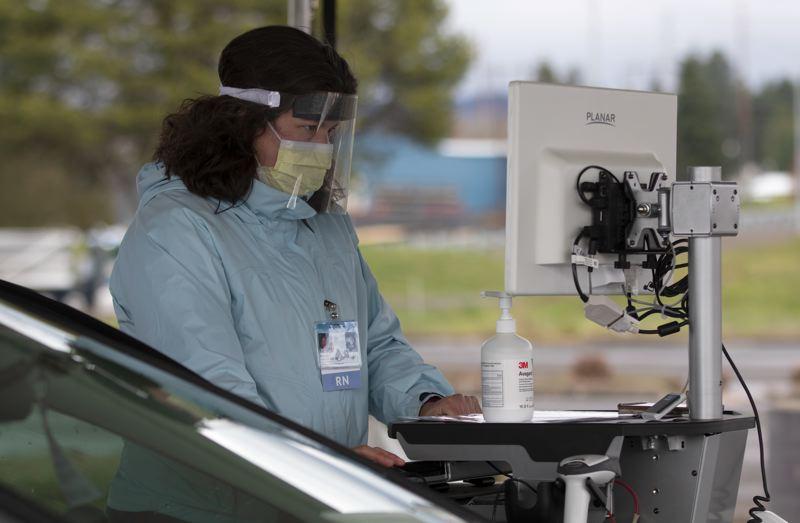
A huge lag in the time it takes for Oregonians to learn if they’ve tested positive for COVID-19 is severely hampering the state’s efforts to curb the rapid spread of the disease, state and local officials said Monday.
In some cases, it’s taken up to 14 days for Oregonians to learn if they’ve contracted the novel coronavirus, according to the Oregon Health Authority. By then, they might have already infected untold others during their most contagious period. By then, when public health officials finally call, those infected might already have forgotten some of the places and people they’d visited weeks earlier. That’s rendering contact tracing -- the system of tracking down all known contacts of the infected person to warn them to quarantine or get tested -- much less effective.
“This, of course, makes our ability to keep up with the virus very difficult,” said Dr. Jennifer Vines, health officer for Multnomah County.
Vines and other public health officials say a crucial window for containing the virus is being missed. One study found that people are most infectious about 17 hours before they start showing symptoms. On top of that, according to the U.S. Centers for Disease Control and Prevention, most people with mild or moderate symptoms probably are no longer contagious 10 days after they first started showing symptoms.
Oregon officials say national shortages in testing kits and supplies have spurred the long delays for test results, especially as demand soars in hot spots such as Florida, Arizona, Texas and California. Nationally, labs also are reporting turnaround times of up to two weeks, when ideally test results should be available in 24 hours or less.
Officials at the Oregon Health Authority say the lengthy delays aren’t just a fluke: They’ve been “receiving widespread reports of extended turnaround time from commercial laboratories.”
“We’re working diligently on this issue, but given that the supply chain disruptions are national, this is a difficult problem to solve,” said Dr. Melissa Sutton, senior health advisor at the Oregon Health Authority.
The holdup appears to be mostly at commercial or private laboratories. The state’s public health lab is reporting turnaround times of one to three days.
Vines, Multnomah County’s health officer, said the prolonged waits are coming at a time when the virus is reaching numbers never seen before in Oregon.
On Sunday, Multnomah County broke its previous record for new cases, with 123 positive test results. That same day, the state reported 436 new cases -- one shy of the record set on Thursday.
Monday, Vines pleaded with the public to take COVID-19 as seriously as they did in the first days of the pandemic, after the governor issued her statewide stay-at-home order on March 23. After the governor started lifting the order May 15, people relaxed many of the protocols that had kept the virus at bay: Refraining from socializing with others, especially indoors; keeping at least six feet from people they don’t live with, avoiding travel, consistent mask wearing and frequent hand washing, Vines said.
She said the virus’ transmission is accelerating because of the individual choices Oregonians make.
“It’s people mixing with their close family and social contacts, probably letting down their guard in terms of distancing and masking and other precautions that may not feel natural to do around people you know well and consider loved ones,” Vines said.
Vines gave the example of friends renting an Airbnb together. She said returning to the workplace and sending children to daycare also is leading to “the kind of social mixing that fuels the spread of this virus.”
Worsening the situation, public health officials are encountering a new reluctance among some people who’ve tested positive to shares the names of people they’ve been in contact with, Vines said. Some businesses also have been unwilling to cooperate, she said.
That could be contributing to an unsettling result: Contact tracers have been unable to track down the sources of 47% of the people who’ve been infected. That’s an all-time high since the state began reporting the data in early May -- and far above the threshold of 30% or less that the state has set as a goal to control the spread of the virus.
In the Portland area encompassing Multnomah, Washington and Clackamas counties, the untraceable case figure is even higher: 54%, according to the latest figures available for the week of July 5-11.
Public health officials say those figures also indicate that the virus is spreading uncontrolled in the community, in what they call “sporadic spread.”
Vines said public health officials and the governor’s team are closely watching the situation. The ultimate decision about whether to rollback reopening of the state, however, rests solely with the governor.
“We’re clearly headed the wrong way, and I think we’ll be having some very active discussions this week on what will be the next steps,” Vines said.
Charles Boyle, a spokesman for Gov. Kate Brown, told The Oregonian/OregonLive in an email Monday that Oregon’s delays in testing result turnaround times are “incredibly concerning.” He also said the growth in cases across Oregon “is alarming.”
But he didn’t directly answer a question about what would prompt the governor to rollback the state’s reopening or issue an all-out stay-at-home order again.
“We are implementing targeted interventions such as wearing face coverings and maintaining physical distancing that are proven to be effective and can stop the spread of COVID-19 and keep our communities and businesses open if we all work together,” Boyle wrote. “However, if Oregon’s COVID-19 cases continue to rise further, Governor Brown will issue more restrictive measures to prevent our health care systems from being overwhelmed.”
-- Aimee Green; [email protected]; @o_aimee
This story was originally published by The Oregonian/OregonLive and is posted here through a coronavirus-sharing arrangement among more than a dozen media outlets.